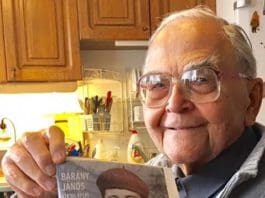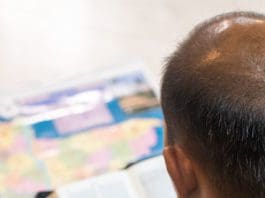
–Late Author Accused Of Stealing Identity
By Stefan J. Bos, Chief International Correspondent BosNewsLife reporting from Budapest
BUDAPEST, HUNGARY (BosNewsLife)– A Hungarian-born Jewish survivor of Nazi death camps isn’t surprised that only a few people attended the funeral for self-proclaimed Holocaust witness and famed author Elie Wiesel. “They buried Wiesel quickly after his death so journalists could not see that he didn’t have a tattoo of the Auschwitz-Birkenau extermination camp,” said Nikolaus (Miklós) Grüner.
The 89-year-old, who survived the notorious Auschwitz and Buchenwald camps during World War Two, claims Wiesel stole the identity and manuscript of his fellow inmate and Hungarian Jewish friend Lázár Wiesel. “Lázár saved my life. But Elie Wiesel is an imposter who was never in a concentration camp,” Grüner told BosNewsLife. Grüner spoke in Budapest on his way to Australia to publish his book ‘Stolen Identity, A-7713’ about Wiesel, who died last year at age 87.
The book is part of his decades-long investigation into Wiesel’s role in what became known as “the Holocaust.” Grüner prefers to use the word “Shoah” when describing the extermination of some 6 million Jews and others the Nazis didn’t like. “The word Holocaust was coined by [people like] Wiesel but means ‘self-destruction.’ I also used it in the past. But we should use the Hebrew word Shoah.”

The outspoken survivor said his tensions with Wiesel emerged in 1986 when the author received the Nobel Peace Prize. “In 1986 a Swedish newspaper arranged for me to meet him at the Grand Hotel in Stockholm. I thought I would meet my friend. Instead, it was Elie Wiesel, a heavily perfumed man who I never met before.”
TATTOO IDENTITY
Wiesel also refused to show his tattoo, Grüner recalled. “That was very strange. The tattoo shows the identity of a true survivor. But this man didn’t even speak Hungarian or Jewish, but just English with a French accent. It was a tense and short meeting.”
BosNewsLife saw photos and film footage showing a man resembling Wiesel in short sleeves without a visible tattoo. Grüner also showed a BosNewsLife reporter a picture of what he said was the lower arm of his friend Lazar Wiesel with tattoo A-7713. BosNewsLife has not been able to verify the pictures independently.
However, Wiesel claimed throughout his life that he carried that number on his arm. “I don’t need that to remember, I think about my past every day,” he once told American students when asked about the tattoo. “I still have it on my arm – A-7713. At that time, we were numbers. No names, no identity,” he added.
Grüner suggested that Wiesel committed deception by impersonating his friend Lázár Wiesel who was born 1913 in Marmaros, Hungary. The first names “Elie” and “Lázár” are similar to the Hebrew name, Eleazar.
Grüner said Hungarian authorities could prove that Wiesel isn’t even Hungarian. “His name is nowhere in the lists of Nazi death camps, and I am sure also not in birth registers.” But Grüner lost a five-year court battle demanding more information. “Hungary’s government refuses to cooperate because they don’t want to admit that they have given a high state award to an imposter. I blame the Hungarian ministry that they cheated the people of the world.”
HUNGARIAN RABBI

During the trial, he summoned a prominent Hungarian rabbi who helped organize Wiesel’s historic visit to Hungary in 2009 to appear in court because he “knew that this man is not a genuine survivor.”
Grüner launched the case after Rabbi Slomó Köves accused him publicly of “falsifying history”.
The rabbi also compared him to American academic Norman Finkelstein who wrote ‘The Holocaust Industry.’
Finkelstein’s controversial book alleges that Jewish leaders are fueling Europe’s anti-Semitism by forcing German and Swiss banks to pay new compensation to those who suffered under the Nazis. Grüner demanded that the rabbi takes back his words and publicly explains “the truth” about Wiesel.
An appeals court in Budapest upheld a previous ruling saying while Köves remarks were “harsh” they were “within the boundaries of freedom of expression.” The court also concluded that it was up to historians to decide if Wiesel was a “genuine Holocaust survivor.”
QUESTIONS REMAIN
Rabbi Köves, who leads the Unified Hungarian Jewish Congregation, shares that view. “How can you steal someone’s identity?”, he asked BosNewsLife at the time. “Wiesel received the Nobel Peace Prize for his books, not for who he was or where he was born.”

But Grüner said that the court refused to take him seriously and denied him a fair trial. Last month, he also failed in his attempt to hear his case at the European Court of Human Rights in Strasbourg. “They even destroyed my papers saying I didn’t sign it. That was not true. I think there is a conspiracy among European countries. Nobody wants to admit that they gave British, Hungarian and other high state awards to an imposter.”
In 2012, Wiesel said he was repudiating the Grand Cross Order of Merit bestowed by the president, a prestigious Hungarian award he received in 2004. He complained that government delegates attended a ceremony for a Nazi sympathizer and said his parents and sister were sent to their deaths by wartime Hungarian officials. Wiesel told BosNewsLife in separate remarks that he was concerned about the rise of far-right party Movement for a Better Hungary, or Jobbik.
Though he faces an uphill battle, Grüner wants to continue his fight against what he views as Elie Wiesel’s lies. “I promised my father that I would tell the world the truth about what happened in the Shoah,” he said. “It’s important that the next generations know what happened.” Grüner said his life in Hungary ended in 1944 when “They destroyed our home in the town of Nyíregyháza, nearly exterminated my family and killed hundreds of thousands of other Jewish people.”
He saw that “Hungarians were eager to close the overcrowded carriages of the death trains.” And, Grüner stressed, “They took our assets, and they put a lock on the outside of wagon with 93 people stashed inside.”
FAMILY GASSED
His family arrived in Auschwitz-Birkenau where his mother and younger brother were gassed immediately in the day-and-night working ovens of the Nazi complex. Grüner’s father was later sent to the crematorium when he could no longer work. “He was killed around Yom Kippur” an emotional Grüner recalled, referring to the ‘Day of Atonement’, seen as the holiest day of the year in Judaism.

As a 15-year-old boy, he befriended Lázár Wiesel, who was among those protecting him, during death marches and heavy, dangerous work. “Everyday I realized I could be the next person to be gassed.”
In January 1945, as the Russian army was coming, the inmates were transferred from a satellite camp of Auschwitz-Birkenau to Buchenwald in Germany.
During the death march, partly by foot, partly by open train, over half of the inmates died. “We kept warm laying on dead bodies,” Grüner explained.
Soon after, Abraham, the elder brother of Lázár Wiesel also passed away.
In April 1945 the U.S. army liberated Buchenwald where they discovered Nikolaus Grüner, Lázár Wiesel, and other survivors. “Elie Wiesel is not in that famous liberation photo with us, despite his claims to the contrary,” Grüner stressed.
MANUSCRIPT TRANSLATED
As the severely malnourished Grüner had tuberculosis, he was sent to a Swiss clinic and separated from his friend Lázár Wiesel. “I never saw him again. Perhaps he was killed.”
While searching for him, he discovered that his friend had written an 862-page manuscript in Yiddish titled ‘Un dit velt hot gesvign’ (‘And the world kept silent’) about his camp experiences. It was published in Argentina. Lázár Wiesel later came back to France where it was copyrighted in 1948, Grüner said. “The influential French author François Charles Mauriac translated it into French. Since Mauriac was not a camp survivor, he used a young man named Elie Wiesel to become the ‘author’ of that book which sold about 11 million copies in different languages. But it was based on the writings of my friend.”
Elie Wiesel, Grüner claims, became the poster boy of “a Holocaust industry” as he looked good on camera’s and knew how to deal with media. “I believe he was never born in Hungary,” Grüner said.

Wiesel claimed during his life that he was born in Sighet (now Sighetu Marmației), Maramureș in the Carpathian Mountains in Romania, that was once part of Hungary. “Who was his father or mother? In 30 years we could not find evidence for the future generations to show what happened. History shouldn’t be forged,” countered Grüner citing alleged inconsistencies in Wiesel’s writings.
After the Second World War, Grüner recovered from camp-related illnesses and eventually emigrated to Australia, where he worked as a painter and sculptor “even for the Catholic Church.” He eventually settled in Sweden to help his brother with a food processing business. “I didn’t want to return to Hungary. I even changed my Hungarian first name Miklós into Nikolaus,” he explained.
Some 600,000 Hungarian Jews died in the Shoah. Nikolaus Grüner still hopes to one day say a Jewish prayer at the grave of the friend who helped him survive these horrors. “Otherwise my life is worthless.”
———————-
(Below Hungarian film footage. BosNewsLife is not necessarily endorsing the title of the documentary, but it gives additional inside in the circumstances faced by Nikolaus (Miklós) Grüner and his decision to investigate Elie Wiesel’s claims).
https://www.youtube.com/watch?v=5HlCwoJMBDI




Of course he was not Hungarian, he was Jewish Romanian. Duh.